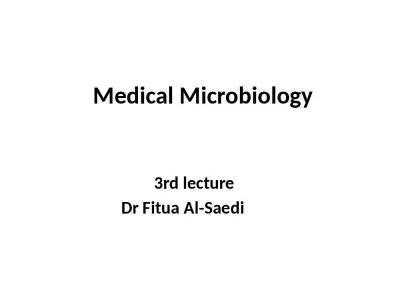

lecture Dr Fitua Al Saedi Bacillus Species The genus Bacillus includes large aerobic sporeforming Grampositive rods occurring in chains ID: 912191
Download Presentation The PPT/PDF document "Medical Microbiology 3rd" is the property of its rightful owner. Permission is granted to download and print the materials on this web site for personal, non-commercial use only, and to display it on your personal computer provided you do not modify the materials and that you retain all copyright notices contained in the materials. By downloading content from our website, you accept the terms of this agreement.
Slide1
Medical Microbiology
3rd
lecture
Dr
Fitua
Al-
Saedi
Slide2Bacillus
Species
The genus
Bacillus
includes large aerobic,
spore-forming
,
Gram-positive rods occurring in chains.
Most members of this genus are saprophytic organisms
prevalent in soil, water, air and on vegetation,
such as
Bacillus subtilis
&
B. cereus
.
Some are insect pathogens, such as
B. thuringiensis
. This
organism is also capable of causing disease in humans.
B. cereus
can grow in foods and cause
food poisoning
by producing either an enterotoxin (diarrhea) or an emetic toxin (vomiting).
B. anthracis
,
which causes
anthrax,
is the principal pathogen
of the genus.
Slide3Morphology and identification
A. Typical Organisms
The typical cells, measuring 1 × 3–4
μm, have square ends and are arranged in long chains; spores are located in the center of the bacterial cell.
Slide4Colonies of
B. anthracis
are
f
lat
or slightly convex with irregular
edge and have a ground-glass appearance in transmitted light.
B. Culture
Hemolysis
is uncommon with
B anthracis but common with B cereus.
B.
anthracis
B. cereus
…..Morphology and identification
Gelatin is liquefied by B. cereus. B. anthracis growth in gelatin stabs resembles an inverted fir tree.
Bacillus
cereus
colonies are large
flat and
dry.
Slide5C. growth Characteristics
The bacilli use simple sources of nitrogen and carbon for energy and growth.
The spores are resistant to environmental changes, withstand dry heat and certain chemical disinfectants for moderate periods, and persist for years in dry earth. Animal products contaminated with anthrax spores (
eg
, hides, bristles, hair, wool, bone) can be sterilized by autoclaving.
Slide6Bacillus anthracis
Pathogenesis
Anthrax is primarily a disease of herbivores—goats, sheep, cattle, horses, and so on; other animals (eg, rats) are relatively resistant to the infection.
In animals, the entry of spores is via mouth and the gastrointestinal tract.
Clinical infections in humans,
Humans become infected incidentally by contact with infected animals or their products. B anthracis causes three categories of disease in humans depending on the point of entry of the spores:Cutaneous anthrax (95%) : the infection is usually acquired by the entry of spores through injured skin. inhalation anthrax or wool sorters’ disease (5%):
inhalation of the spores from the dust of wool, hair, or hides.
Gastrointestinal anthrax (rare): the infection is acquired by ingestion of contaminated meat.
Slide7Virulence factors
The poly-d-glutamic acid capsule
is anti-phagocytic. The capsule gene is present on a plasmid, pXO2.
Anthrax toxins are made up of three proteins:Protective antigen (PA),Edema factor (EF),
Lethal factor (LF).
PA binds to specific cell receptors, and after proteolytic activation,
it forms a membrane channel that mediates entry of EF and LF into the cell. EF with PA, it forms a toxin known as edema toxin.LF plus PA form lethal toxin, which is a major virulence factor and cause of death in infected animals and humans. The anthrax toxin genes are encoded on plasmid, pXO1.
Slide8-
95% human cases are cutaneous
infections
-1 to 5 days after contact -Small, pruritic, non-painful papule at inoculation site-Papule develops into hemorrhagic vesicle & ruptures
-Slow-healing painless ulcer covered with black eschar surrounded by edema
Infection may spread to lymphatics .
-Septicemia may develop.Cutaneous anthrax
Slide9Diagnostic Laboratory Tests
Specimens
to be examined are fluid
or pus from a local lesion, blood, pleural fluid, and cerebrospinal fluid in inhalational anthrax associated with sepsis and stool or other intestinal contents in the case of gastrointestinal anthrax.
Stained
smears
Gram stain show chains of large gram-positive rodsCulture When grown on blood agar plates, the organisms produceNon-hemolytic gray to white, tenacious colonies with a roughtexture and a ground-glass appearance. Comma-shapedoutgrowths (
Medusa head, “curled hair”) may project fromthe colony.
In semisolid medium, anthrax bacilli are always non-motile.
Slide10Definitive
identification requires lysis by a
specific
anthrax -bacteriophage, Detection of the capsule by fluorescent antibody,
identification
of toxin genes by polymerase chain reaction (PCR
), - Enzyme-linked immunoassay (ELISA) Clinical laboratories that recover large gram-positive rods from blood, cerebrospinal fluid, or suspicious skin lesions, which phenotypically match the description of B anthracis as mentioned, should immediately contact their public health laboratory and send the organism for confirmation. …..Diagnostic Laboratory Tests
Slide11Vaccines
(
AVA
BioThrax) In the United States, the current FDA-approved vaccine (AVA
BioThrax) is made from the supernatant of a cell free culture of an
unencapsulated
but toxigenic strain of B. anthracis.Dosage:The dose schedule is 0.5 mL administered intramuscularlyat 0, and 4 weeks and then at 6, 12, and 18 months followed by annual boosters. The vaccine is available only to the U.S.Department of Defense and to persons at risk for
repeated exposure to B anthracis
. Raxibacumab is a human monoclonal antibody against Bacillus anthracis
protective antigen PA
Slide12Treatment
Ciprofloxacin
Penicillin G, along with gentamicin or streptomycin.
Slide13Bacillus cereus
Produces emetic toxin and enterotoxins.
Food poisoning
caused by B cereus has two distinct forms,Emetic type, which is associated with fried rice.nausea, vomiting, abdominal cramps, and occasionally diarrhea
Incubation period 1–5 hours.
Diarrheal type
, which is associated with meat dishes and sauces.Incubation period of 1–24 hours diarrhea with abdominal pain and cramps; fever and vomiting are uncommon. Eye infections, Endocarditis, meningitis, osteomyelitis, and pneumonia.
Slide14Treatment
Vancomycin
or
Clindamycin with or without an aminoglycoside.
Slide15Differences between
B. anthracis
and
B. cereus